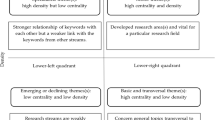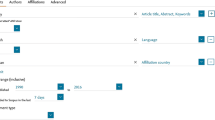Abstract
A review of energy subsidy research from a bibliometric perspective was conducted. Based on the bibliometric method, a statistical analysis of energy subsidy–related publications from 1997 to 2016 was undertaken using the Science Citation Index (SCI) and Social Science Citation Index (SSCI) databases. A total of 1182 publications were retrieved, with a significant increase in the number of publications observed after 2006. The majority of these publications were within the disciplines of Energy & Fuels and Environmental Science & Ecology. Although the USA and China contributed the most papers, authors from 96 countries were involved in the various studies. The USA was the center of global collaborations, while other countries/territories mainly conducted bilateral or regional collaborations in their research activities. Five of the top 11 most productive institutes were from China, followed by the USA. The frequency of collaborations among institutes was relatively low. However, the institute–keyword 2-mode network showed that institutes had great potential to cooperate on a number of common topics. Five major themes were identified from the co-keywords analysis: general renewable energy research, bio-energies, sustainability, subsidies, and welfare. The findings, as a complement to previous conventional reviews, will be useful in future energy subsidy research.





Similar content being viewed by others
References
Badcock J, Lenzen M (2010) Subsidies for electricity-generating technologies: a review. Energ Policy 38(9):5038–5047
Bastian M, Heymann S, Jacomy M (2009) Gephi: an open source software for exploring and manipulating networks. The Third International AAAI Conference on Weblogs and Social Media
Blondel VD, Guillaume JL, Lambiotte R, Lefebvre E (2008) Fast unfolding of communities in large networks. J Stat Mech 2008(10):155–168
Bougette P, Charlier C (2015) Renewable energy, subsidies, and the WTO: where has the ‘green’ gone? Energy Econ 51:407–416
Dansie G, Lanteigne M, Overland I (2010) Reducing energy subsidies in China, India and Russia: dilemmas for decision makers. Sustainability 2(2):475–493
Dartanto T (2013) Reducing fuel subsidies and the implication on fiscal balance and poverty in Indonesia: a simulation analysis. Energ Policy 58(5):117–134
Davis LW (2013) The economic cost of global fuel subsidies. Nber Working Papers 104(5):581–585
Du H, Wei L, Brown MA, Wang Y, Shi Z (2013) A bibliometric analysis of recent energy efficiency literatures: an expanding and shifting focus. Energy Effic 6(1):177–190
Du H, Li N, Brown MA, Peng Y, Shuai Y (2014) A bibliographic analysis of recent solar energy literatures: the expansion and evolution of a research field. Renew Energy 66(6):696–706
Dube I (2003) Impact of energy subsidies on energy consumption and supply in Zimbabwe. Do the urban poor really benefit? Energ Policy 31(15):1635–1645
Faaij APC (2006) Bio-energy in Europe: changing technology choices. Energy Policy 34(3):322–342
Gao C, Sun M, Geng Y, Wu R, Chen W (2016) A bibliometric analysis based review on wind power price. Appl Energy 182:602–612
Garfield E (2006) The history and meaning of the journal impact factor. Jama 295(1):90
Geng Y, Chen W, Liu Z, Chiu ASF, Han W, Liu Z, Zhong S, Qian Y, You W, Cui X (2017) A bibliometric review: energy consumption and greenhouse gas emissions in the residential sector. J Clean Prod 159:301–316
Hertwich EG, Gibon T, Bouman EA, Arvesen A, Suh S, Heath GA, Bergesen JD, Ramirez A, Vega MI, Shi L (2015) Integrated life-cycle assessment of electricity-supply scenarios confirms global environmental benefit of low-carbon technologies. Proc Natl Acad Sci U S A 112(20):6277–6282
Hill J, Nelson E, Tilman D, Polasky S, Tiffany D (2006) Environmental, economic, and energetic costs and benefits of biodiesel and ethanol biofuels. Proc Natl Acad Sci U S A 103(30):11206–11210
Jorgensen SE, Fath BD (2014) Encyclopedia of ecology. Newnes (The details of the book is presented here: https://www.elsevier.com/books/encyclopedia-of-ecology/jorgensen/978-0-444-52033-3
Kalkuhl M, Edenhofer O, Kai L (2011) Renewable energy subsidies: second-best policy or fatal aberration for mitigation? Resour Energy Econ 35(3):217–234
Kander A, Stern DI (2014) Economic growth and the transition from traditional to modern energy in Sweden. Energy Econ 46:56–65. https://doi.org/10.1016/j.eneco.2014.08.025
Kennedy CA, Stewart I, Facchini A, Cersosimo I, Mele R, Chen B, Uda M, Kansal A, Chiu A, Kim KG, Dubeux C, Lebre la Rovere E, Cunha B, Pincetl S, Keirstead J, Barles S, Pusaka S, Gunawan J, Adegbile M, Nazariha M, Hoque S, Marcotullio PJ, González Otharán F, Genena T, Ibrahim N, Farooqui R, Cervantes G, Sahin AD (2015) Energy and material flows of megacities. Proc Natl Acad Sci U S A 112(19):5985–5990
Kopetz H (2013) Renewable resources: build a biomass energy market. Nature 494(7435):29–31
Lesser JA, Su X (2008) Design of an economically efficient feed-in tariff structure for renewable energy development. Energ Policy 36(3):981–990
Liu W, Li H (2011) Improving energy consumption structure: a comprehensive assessment of fossil energy subsidies reform in China. Energ Policy 39(7):4134–4143
Lo K (2014) A critical review of China’s rapidly developing renewable energy and energy efficiency policies. Renew Sust Energ Rev 29(C):508–516
Mao G, Liu X, Du H, Zuo J, Wang L (2015a) Way forward for alternative energy research: a bibliometric analysis during 1994–2013. Renew Sust Energ Rev 48:276–286
Mao G, Zou H, Chen G, Du H, Zuo J (2015b) Past, current and future of biomass energy research: a bibliometric analysis. Renew Sust Energ Rev 52:1823–1833
Mckitrick R (2016) Global energy subsidies: an analytical taxonomy. Energ Policy 101:379–385
Mongeon P, Paul-Hus A (2015) The journal coverage of Web of Science and Scopus: a comparative analysis. Scientometrics 106:213–228. https://doi.org/10.1007/s11192-015-1765-5
Mrvar A, Batagelj V (2016) Analysis and visualization of large networks with program package Pajek. Complex Adapt Syst Model 4:1–8. https://doi.org/10.1186/s40294-016-0017-8
Murray BC, Cropper ML, De C, Francisco C, Reilly JM (2014) How effective are US renewable energy subsidies in cutting greenhouse gases? Am Econ Rev 104(5):569–574
Najmi A, Rashidi TH, Abbasi A, Waller ST (2017) Reviewing the transport domain: an evolutionary bibliometrics and network analysis. Scientometrics 110(2):1–23
Niesten E, Jolink A, Chappin M (2017) Investments in the Dutch onshore wind energy industry: a review of investor profiles and the impact of renewable energy subsidies. Renew Sust Energ Rev 81:2519–2525
Niu B, Hong S, Yuan J, Peng S, Wang Z, Zhang X (2014) Global trends in sediment-related research in earth science during 1992–2011: a bibliometric analysis. Scientometrics 98(1):511–529
Paulo AFD, Geciane P (2017) Solar energy technologies and open innovation: a study based on bibliometric and social network analysis. Energ Policy 108:228–238
Rao ND (2012) Kerosene subsidies in India: when energy policy fails as social policy. Energy Sustain Dev 16(1):35–43
Shen J, Luo C (2015) Overall review of renewable energy subsidy policies in China – contradictions of intentions and effects. Renew Sust Energ Rev 41:1478–1488
Solaymani S, Kari F (2014) Impacts of energy subsidy reform on the Malaysian economy and transportation sector. Energ Policy 70(7):115–125
Sovacool BK (2017) Reviewing, reforming, and rethinking global energy subsidies: towards a political economy research agenda. Ecol Econ 135:150–163
Sovacool BK, Dworkin MH (2015) Energy justice: conceptual insights and practical applications. Appl Energy 142:435–444
Stern DI, Kander A (2012) The role of energy in the industrial revolution and modern economic growth. Energy J 33:1–28. https://doi.org/10.5547/01956574.33.3.5
The MathWorks, Inc. (2017) Matlab and Statistics Toolbox Release 2017b. Natick (The details is presented here: https://www.researchgate.net/post/How_to_cite_a_Matlab_toolbox_in_academic_research
Verma IM (2015) Impact, not impact factor. Proc Natl Acad Sci U S A 112:7875–7876
Wang Q (2010) Effective policies for renewable energy—the example of China’s wind power—lessons for China’s photovoltaic power. Renew Sust Energ Rev 14:702–712
Wang MH, Yu TC, Ho YS (2010) A bibliometric analysis of the performance of Water Research. Scientometrics 84(3):813–820
Wang Y, Lai N, Zuo J, Chen G, Du H (2016) Characteristics and trends of research on waste-to-energy incineration: a bibliometric analysis, 1999–2015. Renew Sust Energ Rev 66:95–104
Xie S, Zhang J, Ho YS (2008) Assessment of world aerosol research trends by bibliometric analysis. Scientometrics 77(1):113–130
Yu H, Wei YM, Tang BJ, Mi Z, Pan SY (2016) Assessment on the research trend of low-carbon energy technology investment: a bibliometric analysis. Appl Energy 184:960–970
Zanghelini GM, Junior HRADS, Kulay L, Cherubini E, Ribeiro PT, Soares SR (2016) A bibliometric overview of Brazilian LCA research. Int J Life Cycle Assess 21(12):1–17
Zhao HR, Guo S, Fu LW (2014) Review on the costs and benefits of renewable energy power subsidy in China. Renew Sust Energ Rev 37:538–549
Zhu J, Hua W (2017) Visualizing the knowledge domain of sustainable development research between 1987 and 2015: a bibliometric analysis. Scientometrics 110(2):1–22
Acknowledgment
The authors would like to thank Professor Song Hong for his guidance on the bibliometrics.
Funding
This research is supported by the Scientific Research Project of Education Department of Hubei Province (Q20182202).
Author information
Authors and Affiliations
Corresponding authors
Additional information
Responsible editor: Philippe Garrigues
Publisher’s note
Springer Nature remains neutral with regard to jurisdictional claims in published maps and institutional affiliations.
Rights and permissions
About this article
Cite this article
Wang, Z., Wang, Y., Peng, S. et al. Mapping the research of energy subsidies: a bibliometric analysis. Environ Sci Pollut Res 26, 28817–28828 (2019). https://doi.org/10.1007/s11356-019-06025-w
Received:
Accepted:
Published:
Issue Date:
DOI: https://doi.org/10.1007/s11356-019-06025-w




